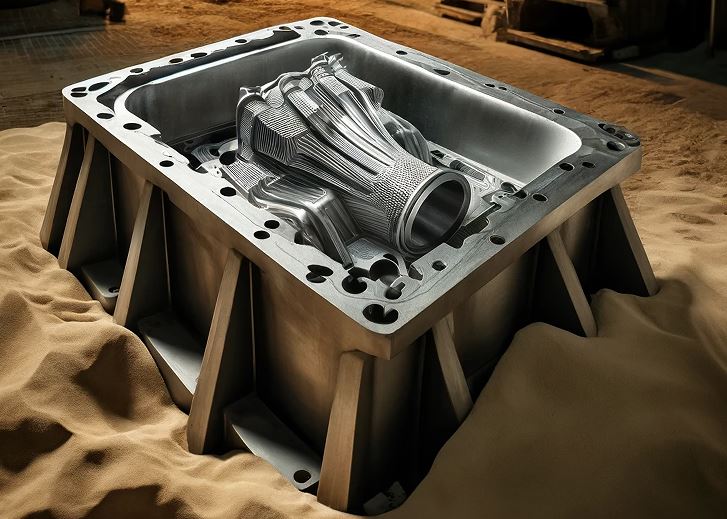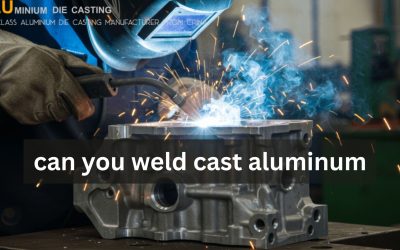Overview of Sand Casting and Aluminum Alloys
To make sand cast aluminum alloys, other metals are mixed with aluminum to take advantage of its unique properties while also making it more useful in a wider range of business situations. Because of how it is made, it is much easier to change the material’s properties to meet specific performance requirements for uses that need resistance to environmental factors, weight, and power all at the same time. In situations where all three of these traits are needed at the same time but in different amounts, this is especially helpful.
Making complicated forms out of molten metal and sand molds is known as sand casting. You have a lot of freedom with this method when making big, complicated parts. This is the beginning of a more in-depth look at sand cast aluminum alloys, which will focus on how important they are to modern business.
Composition of Sand Cast Aluminum Alloys
A lot of aluminum’s special properties can be used in sand cast aluminum alloys, which are designed to make the most of these properties while also giving aluminum more commercial uses. To do this, more metals are added to the mixture to make it stronger. Those additional metals are great for uses that need a balance of mass, longevity, and resistance to meet specific performance needs.
Essential Constituents
Due to its advantageous properties—including low weight, high conductivity, resistance to corrosion, and ability to mold into intricate shapes—aluminum (Al) serves as the alloy’s foundation. As a result of its inherent properties, this material exhibits exceptional suitability for an extensive array of casting applications.
Constantly Alloyed Components
- Silicon (Si): After aluminum, silicon is frequently the most essential alloying element. Generally, it is incorporated in percentages that vary between 5 and 12 percent. Silicon facilitates the casting of intricate, complex components by increasing permeability of the molten alloy, decreasing contraction during solidification, and enhancing resistance to corrosion.
- Magnesium (Mg): The magnesium (Mg) content of the aluminum alloy is optimized to prevent a significant increase in weight while simultaneously enhancing its strength and durability. Additionally, it enhances the alloy’s ductility, a critical property for components undergoing deformation and various forms of tension.
- Copper (Cu): Copper is incorporated into aluminum alloys to increase their strength and durability. Nevertheless, the inclusion of this substance may compromise the alloy’s resistance to corrosion. Consequently, its implementation is carefully evaluated in light of the intended function of the end product.
- Zinc (Zn):Zinc (or Zamak) is a commonly added element that enhances the ductility and strength of the alloy. Furthermore, it enhances the alloy’s resistance to attrition, making it suitable for rigorous applications.
- Iron (Fe): Iron is frequently integrated in alloy castings in minuscule amounts to bolster the resistance of the casting to heated cracking, a prevalent issue resulting from the differential rates of chilling.
Factors Influencing Alloying Elements
The inclusion of these elements in aluminum induces modifications to the physical and mechanical properties of the alloy, in addition to affecting its appropriateness for final applications and casting characteristics. To provide an example, alloys that comprise a higher percentage of silicon are highly suitable for application in automotive components such as transmission housings and engine blocks. This is due to their improved ability to withstand wear and tear and to be cast.

sand cast aluminum alloys
Properties of Sand Cast Aluminum Alloys
Sand casting is typical for metal components, particularly alloys of aluminium. Strong-to-weight ratio, corrosion resistance, and light weight are characteristics of aluminium alloys. In the fabrication of airplanes, automobiles, and building materials, they are useful and flexible. Many goods use sand cast aluminum alloys; this article explains their properties and the reasons producers use them.
It’s crucial that sand cast aluminum alloys be robust. The great strength-to-weight ratio of aluminium alloys allows them to reinforce an object while reducing its weight. Though this affects many industries, weight reduction improves performance and fuel economy in aircraft. Complex forms and thin walls produced by sand casting improve the strength-to-weight ratios of aluminium components.
Sand cast aluminium alloys are strong and resistant to corrosion. Aluminium is corrosion-resistant because, when exposed to air, it forms a protective oxide covering. One layer stops rusting. To improve corrosion resistance, this oxide layer can be powder coated or anodised. Sand cast aluminium alloys work well outside or next to water where salt and moisture can corrode metal.
Excellent thermal conductivity is yet another significant characteristic of sand cast aluminium alloys. Good heat conductor aluminium facilitates effective heat transfer in parts like engine blocks and heat exchangers. When heat control is essential for component performance and lifetime in industrial and automotive applications, this characteristic is especially crucial. The ability to create complicated forms with finely detailed cooling channels made possible by sand casting raises the thermal conductivity of aluminium components even further.
Sand cast aluminium alloys are also easily worked with during the manufacturing process because of their excellent machinability and weldability. Tight tolerance manufacture of complicated, precise components is made possible by this. Manufacturers wishing to produce high-quality aluminium components at scale often use sand casting because technique also makes it possible to build huge components at a reasonable cost.
Advantages and Limitations of Sand Casting Aluminum Alloys
For the manufacture of metal alloy components, sand casting is a method that many economic sectors find to be quite advantageous. Its inherent constraints must be taken into account, though, just like any other way of producing items. To decide wisely on their applications and get the most out of sand casting aluminum alloys, designers and manufacturers must have a thorough awareness of their benefits and drawbacks.
The versatility of the aluminium alloys that can be cast with sand is among its most beneficial features. Because sand casting may handle a wide range of item sizes and types, it can be utilized to produce a small number of components or a big number of parts. Furthermore, complex shapes may be produced with sand casting, something that is challenging or perhaps impossible to do with traditional casting techniques.
Sand casting aluminum alloys has the benefit of requiring little financial outlay. Die casting and investment casting are two more expensive casting techniques than sand casting, which is a very cheap one. Regarding sand casting, two easily found and reasonably priced materials are sand and clay. It is thus a great choice for producers who have to make a lot of components.
An additional great technique to get a very clean surface and exact measurements is sand casting. Making changes to the sand models used in casting is easy and will guarantee that they are the right size and shape. This suggests that the finished product is likewise the right size and shape. Sand casting makes it possible to create parts with smooth surfaces and few finishing steps, which saves even more time and money during the production process.
Still, manufacturers should be aware of the limits that the sand casting method for metal alloys sets. The porousness of the casts made by sand casting is one of its problems. Moulds made of sand can trap gases and air during the casting process. This could make the finished product have holes in it. This might change the casting’s mechanical features, and to make the part better, it might need to go through other steps like heat treatment or impregnation.
When metal alloys are sand cast, there is also the chance that the mould will disappear. Moulds made of sand may break down over time because of the high temperatures and forces used in casting. This could cause parts to be made that aren’t working right. The makers must check and fix the sand moulds on a regular basis to make sure the quality of the castings they make stays the same.
To sum up, sand casting aluminium alloys has many benefits, such as a smooth surface, accurate measurements, the ability to be easily modified, and low cost. But producers need to do something about these problems and know that this casting method has some problems, such as mould degradation and porosity. Manufacturers can choose the best casting method for their needs by understanding the pros and cons of sand casting aluminium metals.
Manufacturing Process of Sand Casting for Aluminum Alloys
Sand casting is a basic and often used method in the metal casting industry, especially for casting aluminium alloys. Because it is so simple and adaptable, it is now the method of choice for producing complex and large metal components. Many crucial steps make up the process, and each one is necessary for the final result to be achieved. People that work in the design, manufacture, or application of cast metal components actually must be well-versed in this procedure.
Sand Mold Design
Sand casting begins with designing a pattern that represents the intended shape of the cast part. It is usual procedure to build this design using metal, plastic, or wood. The pattern needs to be somewhat larger to allow for the metal shrinking that happens during the cooling process. Precision of the pattern is also highly crucial because it directly affects the dimensions and surface quality of the finished cast item.
Sand Mould Manufacturing
Creating a Mould Following pattern placement within a moulding box, sometimes known as a flask, the flask is filled with sand that has been combined with a binding agent to help the sand keep its shape. Both mechanical presses and hand tools are used to compact the sand surrounding the pattern. The design is painstakingly removed once the sand hardens, leaving a hollow that accurately reflects the shape of the pattern.
Constructing the Fundamentals The casting method uses a core to allow the production of complex internal features or cavities. Cores are made from sand and a binder, then hardened and then placed into the mould cavity. Because cores significantly affect the casting’s inner shape, precise placement of them is essential.
Combining pouring and melting
A furnace is used to melt the aluminium alloy, which is chosen according to the properties needed for the finished product, at temperatures between 660 and 750 degrees Celsius, or 1220 and 1382 degrees Fahrenheit. Next, the mold’s cavity and cores are filled with molten aluminium by gently pouring it into the mould. The pouring rate and temperature are two critical variables that greatly affect the casting quality. These elements impact features like porosity and the amount of defects that are created.
Cool and casting removal (demolding)
The molten metal begins to cool and solidify within the mould after it is poured into it. In order to create the cast with the essential mechanical qualities, this cooling interval is absolutely necessary. The cast part can be seen by disassembling the sand mould once the metal has attained the required consistency. The mould has been damaged beyond repair and is thus unfit for further casting; hence, a fresh mould must be used for every succeeding casting.
Finalizing Inspections and Checks
Cleaning and finishing the cast portion is the last step in the sand casting process. Typically, this entails removing unnecessary components like flash, runners, and gates. To achieve the required level of surface polish and dimensional accuracy, it may also be necessary to use sandblasting, grinding, or machining. To ensure it meets all of the standards, the casting is thoroughly inspected in the final process. Visual inspection, dimensional verification, and non-destructive testing methods including x-rays and ultrasounds are some of the most typical inspection methods.
New thoughts and styles on how to cast aluminum metals in sand
Sand casting has become a lot better thanks to recent advances in technology. One way that models and molds are made has changed since 3D printing came along. Older methods took more time and cost more money. On top of that, scientists are always looking into the chemical and physical properties of metals to make new aluminum alloys that will be harder and last longer.
It’s also important for the business to be environmentally sustainable. People are trying to reuse things and make less trash for sand casting to be better for the earth.
That being said
Modern production needs sand cast aluminum alloys a lot because they are flexible, cheap, and good at their job. The tools and materials used for sand casting will keep getting better as technology changes and environmental problems become more important. This change should make sand cast aluminum alloys more useful in businesses all over the world by making them better at what they do.
This in-depth talk not only shows where sand casting technology is now, but it also sets the stage for its future growth. This will lead to more study and new ideas in this area, which is always changing. Learn more about Rotary Air Compressor Parts
Welcome to GC Precision Mould, the best place in China to get high-quality services as a die casting maker and Mould Maker. We are experts at making high-quality plastic moulds, aluminium die casting moulds, and a wide range of die-cast parts from metals like magnesium, zinc, and aluminium.
At GC Precision Mould, we are dedicated to providing the best spray painting services for anodized aluminium and other casting goods. Our experienced engineers and technicians use the newest tools and methods to make sure that every part we make not only meets but also passes the strictest quality and accuracy standards.
Our products are used in many fields, such as automotive, consumer gadgets, medical equipment, and industrial equipment. We work closely with our clients to fully understand their individual needs. This lets us come up with custom solutions that perfectly meet their anodized aluminium spray painting needs.
We can give you great results whether your project needs a single plastic mould or a full die casting production line because we have a lot of experience and resources. Get in touch with us right away to learn more about our services and how we can help you reach your manufacturing goals.
Get in touch with us to get the best deals and the best service on Your project needs Die casting China for anodized aluminium or mould suppliers for injection moulding products with spray paint finishes. Your success is very important to us, and we’re excited to help you with your aluminium die casting projects.





0 Comments